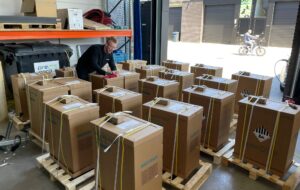With energy costs on the rise and more Americans turning to renewable power, home batteries have become an attractive way to save money and increase energy independence. While they’re often paired with solar panels, a battery system can provide benefits even without solar—especially when you’re on a utility plan with time-based rates. This article breaks down how home batteries operate, what components make them tick, and what you should keep in mind before purchasing one.
The Key Components of a Home Battery System
 A home battery system isn’t just a box of stored energy—it works in tandem with an inverter. This device acts like the brain of the system, managing the flow of electricity. It decides when to store electricity in the battery and when to send it back to your home, depending on how much power you’re using, whether your solar panels are producing, and what electricity prices look like.
A home battery system isn’t just a box of stored energy—it works in tandem with an inverter. This device acts like the brain of the system, managing the flow of electricity. It decides when to store electricity in the battery and when to send it back to your home, depending on how much power you’re using, whether your solar panels are producing, and what electricity prices look like.
The inverter converts electricity from AC (the kind your home uses) into DC for storage in the battery. When energy is needed, it converts the DC back into AC. This two-way conversion is essential, setting battery inverters apart from standard solar inverters or EV chargers.
Different Battery Technologies Matter
Not all batteries are created equal. Most home batteries today use lithium-ion technology—the same that powers your smartphone or electric car. But lithium iron phosphate (LiFePO4) batteries are gaining popularity in residential use because they are safer and last longer. They handle heat better and can be charged many more times without losing capacity, making them a smart choice for homeowners looking for durability.
How Batteries Work with Solar Panels
If you have solar panels, your battery stores any extra power you generate during the day that you don’t immediately use. Instead of sending that surplus energy back to the grid—where you might only get a fraction of the retail rate—you keep it for later, like when the sun goes down. Think of charging your home battery like charging your phone or electric vehicle: the battery’s capacity determines how much energy it can hold for later use.
Most modern home batteries start around 5 to 10 kilowatt-hours (kWh) of storage. The right size depends on your energy use and how much extra solar energy you generate. Many batteries are modular, so you can add more capacity if your energy needs grow.
When Does Your Battery Deliver Power?
After storing energy, your battery supplies power to your home when your solar panels aren’t producing—typically in the evening, overnight, or on cloudy days. Your inverter automatically chooses the best time to use the stored power based on your consumption and electricity prices (if applicable).
This setup lets you use clean, affordable energy from your own battery even when the sun isn’t shining.
Taking Advantage of Time-Based Electricity Rates
Across the US, many utilities offer time-of-use or dynamic pricing plans that charge different rates depending on the time of day. Smart battery systems can charge when electricity is cheapest (like overnight or when renewable energy supply is high) and discharge when prices spike during peak hours.
By shifting when you buy and use electricity, you can lower your energy bills while easing demand on the power grid.
Why Install a Home Battery?
Home batteries provide flexibility and savings. They let you store electricity to use when it’s most cost-effective or environmentally friendly. If paired with solar panels or a time-of-use plan, they can significantly cut your electricity costs.
They also increase your independence from the grid, letting you rely more on your own stored or cheap electricity. Plus, many batteries offer backup power during outages, helping keep your essential devices running.
On a larger scale, batteries help stabilize the grid by balancing energy supply and demand, which supports a cleaner, more resilient energy system nationwide.
Popular Home Battery Options in the US
The market for home batteries is growing fast, with several trusted options:
-
Tesla Powerwall: Known for high capacity, smart features, and easy integration with solar.
-
Enphase Encharge: Modular, safe lithium iron phosphate batteries with strong monitoring.
-
LG Chem RESU: A reliable lithium-ion option compatible with many inverter systems.
-
Generac PWRcell: Designed for backup power and solar integration, scalable for bigger needs.
-
Sonnen: Emphasizes energy management and community energy sharing.
-
Marstek: Reliable and affordable lithium-ion batteries featuring modern technology and strong compatibility for home energy storage.
Other brands like BYD and Panasonic also offer competitive solutions, especially for those wanting lithium iron phosphate technology.
